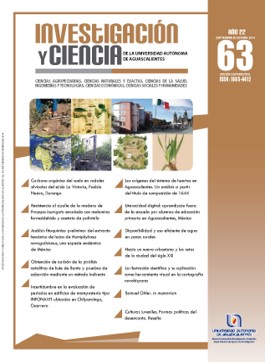Análisis fitoquímico preliminar del extracto hexánico de hojas de Hemiphylacus novogalicianus, una especie endémica de México
DOI:
https://doi.org/10.33064/iycuaa2014633607Palabras clave:
análisis fitoquímico, composición química, Hemiphylacus novogalicianus, especie endémica, muerte de ganado vacunoResumen
En este trabajo se aborda el análisis fitoquímico preliminar (AFP) del extracto hexánico de las hojas de Hemiphylacus novogalicianus, una especie endémica de México. El estudio permitió establecer la posible composición química de la planta. En este análisis se detectó la presencia de lo que pudiesen ser compuestos de tipo indol y sus derivados compuestos con grupos carbonilos, esteroides y
ácidos grasos insaturados.
Descargas
Citas
• BART, H. J. y PILZ S. Industrial scale natural products extraction. Alemania: Wiley-VCH Verlag & Co. KGaA, 2011.
• CHASE, M. An Ordinal Classification for the Families of Flowering Plants. Annals of the Missouri Botanical Garden, 85(4): 531-553, 1998.
• CHASE, M. An Update of the Angiosperm Phylogeny Group Classification for the Orders and Families of Flowering Plants: APG II. Botanical Journal of the Linnean Society, 141(4): 399-436, 2003.
• CHASE, M. et al. Phylogenetics of Asphodelaceae (Asparagales): An Analysis of Plastid rbcL and trnL-F DNA Sequences. Annals of Botany, 86, 935-951, 2000.
• CSEKE, L. J. et al. Natural Products from Plants. 2 ed, USA: CRC Press Taylor & Francis, 2006.
• DOMÍNGUEZ, X. A. Cromatografía en papel y capa delgada. [Serie Química. Monografía 16] Washington, DC: OEA, 1982.
• DOMÍNGUEZ, X. A. Métodos de investigación fitoquímica. México: Limusa, 1973.
• FRIED, B. y SHERMA, J. Practical Thin-layer Chromatograpy. A Multidisciplinary Approach. USA: CRC Press, 1996.
• GARCÍA-ALVARADO, J. S. et al. Traditional Uses and Scientific Knowledge of Medicinal Plants from Mexico and Central America. Journal of Herbs, Spices & Medicinal Plants, 8(2-3): 37-89, 2001.
• GEORGE, J. et al. Phytochemical Research in South Africa. South African Journal of Science, 97(3-4): 93-105, 2001.
• HAMOUCHE, Y. et al. Cytotaxonomy of Autumnal Flowering Species of Hyacinthaceae from Algeria. Plant Systematics and Evolution, 285(3-4): 177-187, 2010.
• HERNÁNDEZ, L. Hemiphylacus novogalicianus L. Hern. México: Instituto de Biología de la UNAM-Colecciones Biológicas, Universidad Nacional Autónoma de México, 2011.
• HERNÁNDEZ, S. L. Fascículo 15. Hyacinthaceae Batsch. [Serie Flora del valle de Tehuacán-Cuicatlán] México, D. F.: Instituto de Biología UNAM, 1997.
• MAHIDOL, C. et al. Biodiversity and Natural Products Drug Discovery. Pure & Applied Chemistry, 70(11): 2065-2072, 1998.
• MASONDO, N. A. et al. Pharmacological Potential and Conservation of the Genus Eucomis (Hyacinthaceae) Endemic to Southern Africa. Journal of Ethnopharmacology, 151, 44-53, 2014.
• MWAFONGO, E. et al. Ethnobotanical Study of Hyacinthaceae and non-Hyacinthaceous Geophytes in Selected Districts of Malawi. Ethnobotany Research & Applications, 8, 75-93, 2010.
• PERRY, P. The Restructuring of the Family Liliaceae. Veld & Flora, 71(3): 66-68, 1985.
• POHL, T. S. et al. Southern African Hyacinthaceae: Chemistry, Bioactivity and Ethnobotany. Current Organic Chemistry, 4(12):
-1324, 2000.
• REYES, R. S. G. et al. Identificación preliminar de los metabolitos secundarios de los extractos acuosos y etanólicos del fruto y hojas de Morinda citrifolia L. “noni” y cuantificación espectrofotométrica de los flavonoides totales. UVC-Scientia, 2(2): 11-22, 2010.
• RÍOS, M. Y. et al. Chemical Constituents from Flourensia resinosa S.F. Blake (Astereaceae). Biochemical Systematics and Ecology, 51, 240-242, 2013.
• RZEDOWSKI, J. Diversidad y orígenes de la flora fanerogámica de México. Acta Botánica Mexicana, 14, 3-21, 1991.
• SARKER, S. D. et al. Natural Products Isolation. 2 ed., USA: Humana Press, 2006.
• SHING, S. A. Herbalism, Phytochemistry and Ethnopharmacology. USA: CRC Press Taylor & Francis, 2011.
• VILLASEÑOR, J. L. Los géneros de plantas vasculares de la flora de México. Boletín de la Sociedad Botánica de México, 75, 105-135, 2004.
• VILLASEÑOR, J. L. y ESPINOSA-GARCÍA, F. J. The Alien Flowering Plants of Mexico. Diversity and Distributions, 2004(10): 113-123, 2004.
• WALLER, C. P. et al. COX-2 Inhibitory Activity of Homoisoflavanones and Xanthones from the Bulbs of the Southern African Ledebouria socialis and Ledebouria ovatifolia (Hyacinthaceae: Hyacinthoideae). Phytochemistry, 95, 284-290, 2013.
Descargas
Publicado
Cómo citar
Licencia
Derechos de autor 2014 Virginia Flores-Morales, Oswaldo Castañeda Hernández, Tomás Montiel Santillán, Gloria Patricia Hernández Delgadillo

Esta obra está bajo una licencia internacional Creative Commons Atribución-NoComercial-CompartirIgual 4.0.
Las obras publicadas en versión electrónica de la revista están bajo la licencia Creative Commons Atribución-NoComercial-CompartirIgual 4.0 Internacional (CC BY-NC-SA 4.0)









